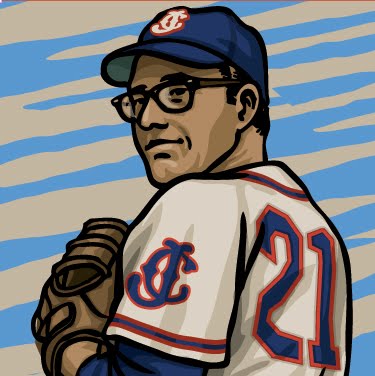 The legend goes like this: A low-level barnstorming team of white minor league ballplayers wearily traveling through the American south-west pull up at a desolate, hot and dusty army post somewhere on the Arizona-Mexico border. The baseball team on this forgotten outpost turns out to be one of the greatest teams the young outfielder of the traveling white team has ever seen, especially a pitcher and catcher named Rogan. He mentally notes the names of the players and when he finally arrives back in his home town of Kansas City all he can do is talk about the great ballplayers he has seen. Unfortunately the great players he has witnessed were all black and the year is 1919. The only man in Kansas City who will listen to young Casey Stengel is J.L. Wilkinson, owner of the all-black Kansas City Monarchs. On his word Wilkinson hires 5 players Casey saw after they are discharged from the Army. These players go on to form the core of the great Monarch teams of the 1920's and 30's.
The legend goes like this: A low-level barnstorming team of white minor league ballplayers wearily traveling through the American south-west pull up at a desolate, hot and dusty army post somewhere on the Arizona-Mexico border. The baseball team on this forgotten outpost turns out to be one of the greatest teams the young outfielder of the traveling white team has ever seen, especially a pitcher and catcher named Rogan. He mentally notes the names of the players and when he finally arrives back in his home town of Kansas City all he can do is talk about the great ballplayers he has seen. Unfortunately the great players he has witnessed were all black and the year is 1919. The only man in Kansas City who will listen to young Casey Stengel is J.L. Wilkinson, owner of the all-black Kansas City Monarchs. On his word Wilkinson hires 5 players Casey saw after they are discharged from the Army. These players go on to form the core of the great Monarch teams of the 1920's and 30's.Makes a great story, but is it true? Not really. Stengel may have played against Rogan and his 25th Infantry Regiment team in Arizona but details are sketchy. Did he recommend the army ballplayers to Wilkinson? Maybe, but Joe Rogan, the pitcher and catcher that Stengel was especially amazed with was actually from Kansas City and had already played for a team owned by Wilkinson back in 1917 while on leave from the service. Chances are Rogan contacted Wilkinson or the other way around and Rogan brought along his other teammates to Kansas City. Black newspapers occasionally ran stories about the black Army baseball teams and Rogan and the 25th Infantry team was fairly well known by 1919. Whatever the truth behind the legend may be, Bullet Joe Rogan became one of the greatest players in history. He was an overpowering and smart pitcher who also hit for power. When ranking ballplayers, I always throw the great Babe Ruth out there to end the discussion for the simple fact that besides being the spectacular hitter he was, the first 5 years of his career was spent as a pitcher and not only did he pitch but he was the best left-hander in baseball. To me that versatility trumps anything any other player can boast and there is only one other player who had that kind of sheer talent, Joe Rogan. Unfortunately his color kept him from competing in the major leagues but we can piece together from the records available that he was every bit as talented as Ruth when it comes to pitching and his hitting became legendary all across the country wherever the Monarchs played ball.
In 1910 Joe Rogan joined the all-black 24th Infantry Regiment and served in the Philippine Islands where he became legendary for his catching and pitching for the regimental team. Discharged in 1914 he soon re-enlisted again, this time with the 25th Infantry at Schofield Barracks in Hawaii which had a powerful ballclub known as the Wreckers. While there he shut out the Portland Beavers of the Pacific Coast League on 3 hits, struck out 13 and hit a double. In 1918 the regiment moved to Camp Little on the Arizona-Mexico border and the team continued its winning record with Sergeant Rogan of the machine gun company credited with an incredible 52 wins in one season. In 1920 Rogan, along with teammates Dobie Moore, Bob Fagan, Oscar Johnson, Hurly McNair and Lem Hawkins went onto form the nucleus of the Kansas City Monarchs, one of the most powerful negro league teams.





